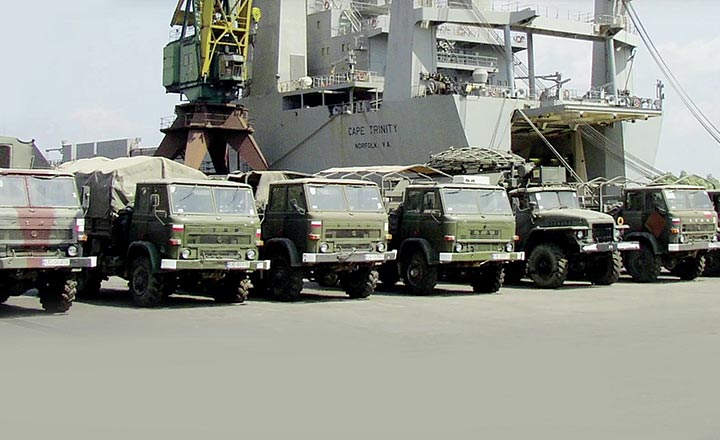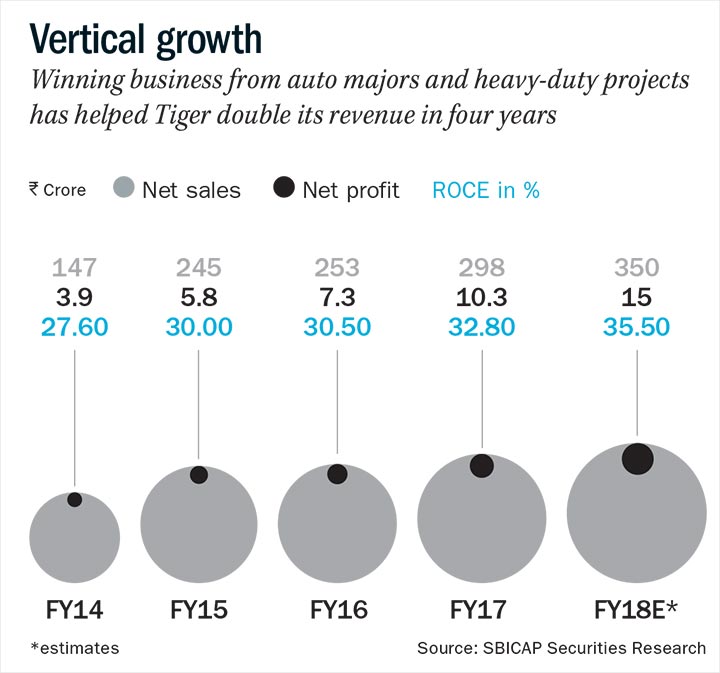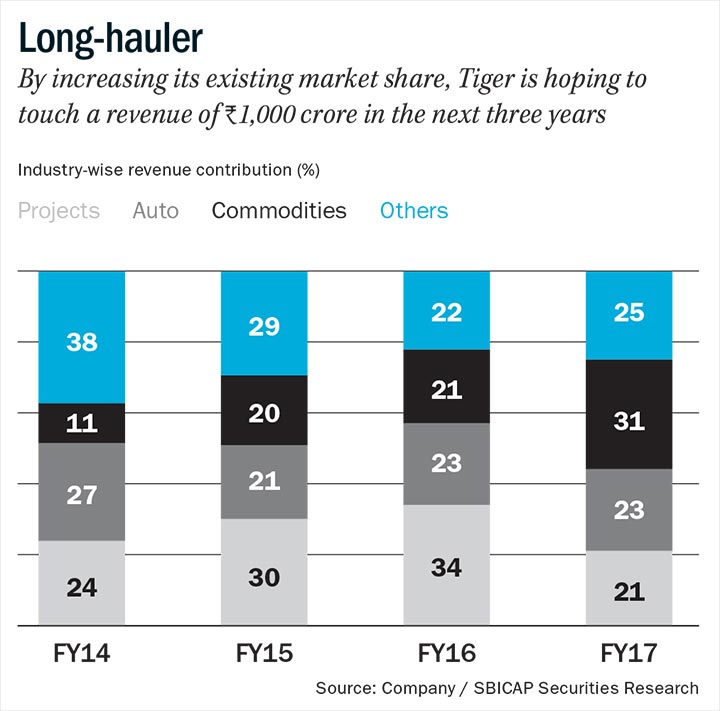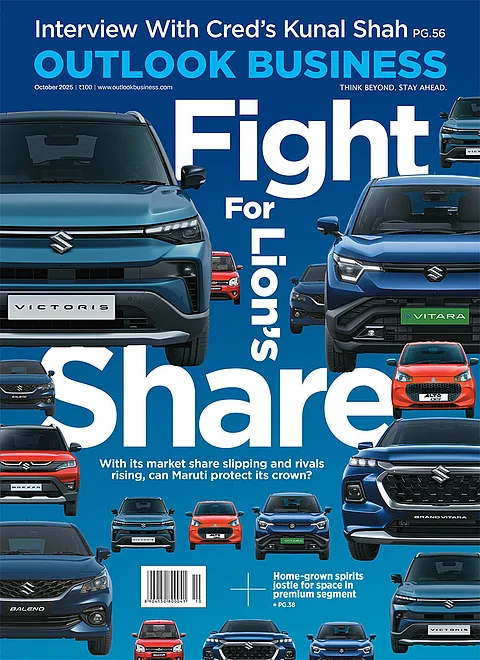Harpreet Singh Malhotra bursts into laughter when asked the reason behind naming his company as Tiger Logistics. “Had I named it Harpreet Logistics or something else, say Fast Logistics, you wouldn’t have asked me this question,” he quips. Jokes apart, it wasn’t a random name that popped in Malhotra’s brain. Eighteen years down the line, Tiger Logistics stands true to what he had in mind (character and aggression) when he named his company after the magnificent beast. The Delhi-based company with a market cap of Rs.208 crore has been growing fast at an impressive 28% per annum offering its customers end-to-end supply chain management. Its array of services include transportation, customs consultancy, customs clearance and international freight forwarding. With projected FY18 revenue of Rs.350 crore, Tiger sure has come a long way from its modest beginnings — an initial investment of Rs.50,000, revenue of a few lakh and a team of eight people.
A first-generation entrepreneur, whose grandfather and father worked in the armed forces, Malhotra was 30-years-old when he set up Tiger in 2000. An IIFT graduate, he was working with Hero MotoCorp handling its logistics. For Malhotra who was used to the military way of life, exposure to civil life came across as a very different experience. That along with an aptitude for international trade and an understanding of the logistics industry planted in him the seed of entrepreneurship. “I was working on the other side of the table as well — not only for logistics, but also for exporters and importers who availed services from the logistics company. Since I had worked on both sides, I realised there was a dearth of good logistics companies to serve these people,” he recollects. This was a time when the industry was quite unorganised. This meant Malhotra had no actual models to follow and everything was driven by gut. Nevertheless his experience with organised companies helped him to mould Tiger as a structured organisation. The company, which started off as a clearing house agent in Delhi later emerged as a full-fledged logistics service provider after getting registered with the Directorate General of Shipping as a multimodal transport operator in 2004. While the company had its own share of teething troubles, Malhotra was clear about one thing — the company had to keep growing no matter what the challenge.
Standing out
The task was cut out in front of him. If the company had to grow, it had to do things differently so that people would take notice. Therefore, Tiger Logistics adopted the strategy of focusing on particular verticals and ensuring that each one kept growing. It started with auto and was quick to move to yarns, textiles, projects and engineering goods. This gave the company a specialist image. Today the company is working with all the majors in the auto sector such as Bajaj Auto, Hero MotoCorp, Honda Motors, Yamaha, TVS, and Mahindra among others and handles the exports and logistics for all the two-wheeler companies in India. It was a big fillip for the company when it bagged the contracts of Bajaj Auto and ISGEC Heavy Engineering. “For us, Bajaj Auto was a big boost, it took me two years getting that business, but today we are handling 100% of their South America volume. In the case of ISGEC, they had never changed a logistics company for 14 years. We are handling 60% of their projects now,” reveals Malhotra. It is not just the founder who is beaming with pride but the client too. Mukund Nerekar, manager – export operations, Bajaj Auto, says, “Tiger Logistics has been handling our major cargo for Latin and Asian markets. Close co-ordination, best freights along with tailor-made services, have made them the best available option for international supply chain.”

Tiger has also emerged as a strong player in projects where it works with all the major companies in India. In fact, the company has added some extra feathers to its cap by taking up quite a few high-risk assignments during the course of its journey. Tiger handled the logistics operations during the construction of Salma Dam in Afghanistan, a hydroelectric irrigation dam project by the ministry of external affairs. The construction took about five years, and Tiger handled the logistics in the war-struck region of Chishti Sharif.
Tiger soon started focusing on more verticals such as cold chain, refrigerated containers and commodities. “India is a country where a lot of disruption takes place and you cannot depend on a particular vertical or region if you want to grow,” says Malhotra. Although the company emerged as a strong player in the auto and textiles and yarn sectors, he realised that there was a saturation point to these businesses. If he wanted to scale up, he had to move to other locations and service more verticals. “I liked to focus on verticals because you get identified with those verticals and then in a network effect one customer attracts another customer. The vertical focused approach also helps us to understand the industry and plan our investments and growth plans according to it,” Malhotra notes. It meant that the company was not dependent on one vertical alone and during lean times in one vertical, it could pull in growth from another. “Some give us more profitability, some give us more volume. So it helps us to balance out. It also helps us on a pan-India basis since consignments from some of these verticals would be moving out of north, some from west and some from the east,” he adds. Tiger today has 15 offices across all major ports in India.
One of the major factors that aided the company’s growth was its investment in technology. “Since I have worked on the other side of the table, it really helped me understand the pain point of customers,” Malhotra remembers. The company, which started investing in technology in its early days, is now looking at a 3x jump in the capital allocation for technology development. “If you are a pan-India company, unless you have the technology to control things, you can’t handle it,” Malhotra points out. Focusing on areas such as track and trace, documentation and financial control, Tiger has invested heavily in technological tools for the same.

Flying high
Defence logistics has been one of the latest verticals that Tiger has entered, something which Malhotra takes pride in. He believes it to be one of the future growth engines. “We must be the only company in India which is moving live ammunitions and guns for the Indian Army and at the same time doing shipments of rice exports from Mundra and tile shipments from Morbi. But defence has a lot of potential, as there is dearth of trustworthy players to handle such a sensitive business,” he says. One of the proud assignments of Tiger was when it carried the Airborne Early Warning and Control Systems (AWACS) from Israel for the Indian Air Force. “We were the first ones to carry AWACS from Israel to India. Handling that was one hell of a job because you can’t fly over Saudi or Sudan. We worked very closely with the Indian Air Force and those in Israel and finally got those shipments to the airforce camp in Agra,” he remembers.
So, how does Tiger go about choosing its verticals? Definitely not a knee-jerk reaction, Malhotra says. “We look at the overall growth of a sector, track its past and present business volume, analyse future growth and then only try and get into it. We were very strong in the Morbi market, but we realised a lot of our capital was getting stuck there. So we decided to move out. We keep taking these decisions depending on market due diligence,” he says. The company also makes sure it chooses the right partners in foreign countries so that it doesn’t falter on tough projects. Tiger has partnered with Falcon in US, Blue Cargo in Colombia and Core in China. The company, which follows an asset-light model has a fleet of about 60 trailers and 150 attached vehicles. On being asked if it was a conscious decision to remain asset-light, Malhotra laughs, “Initially we were forced to be so since we didn’t have any capital. But over the course of time it became our strength. We could take faster decisions and not invest huge amounts in assets.”
The company, however, had its own share of challenges. During its early stage it found it difficult to bag big customers who preferred multinational logistics providers. The entry barrier for Tiger was huge. It also found it tough to attract good talent and had to train the people it hired. In fact, such challenges prompted the company to go to the bourses.

In 2013, when the company got listed on the BSE SME Exchange and subsequently migrated to the main board, it was one of the youngest companies in the logistics space to do so. While the IPO raised Rs.8 crore, Malhotra emphasises that the reason for going public was to get more visibility rather than to raise money. Being a listed company gave it more credibility. The MNC challenge still persists, but Malhotra feels his company is today in a better position to counter them.
Pankaj Gupta, COO, Tiger Logistics, adds, “As far as MNCs are considered there is always a lack of human touch — they are very system driven. As an Indian company, we understand the mentality of Indian customers. Our solutions are not rigid; they are flexible within the spheres of compliance.” According to him, one of the factors that give Tiger an edge over MNCs is its choice of markets, “Take Gujarat for example – we went there and we went deep in. We went to Morbi and Veraval where MNCs weren’t present, but there was enough business there.”
Troubled waters
Alok Industries has been a client of Tiger for the past eight years and Ajay Narayanan, VP (sales), at Alok, agrees with what Gupta says. “If you have any special requirements in terms of custom clearance and or in terms of door delivery to the buyer at the destination, they take care of it. There are several other players in the industry, but you don’t find most of them having all facilities under one roof. That is the advantage with Tiger,” he adds.
However as the company grew, along with it came new challenges. “In FY15 we were a debt free company — but for the past two-three years there has been major financial constraints because from a Rs.100 crore company, we have grown to Rs.300 crore. So getting a bigger credit line has been a problem,” says Malhotra. “Another thing is liquidity. People don’t pay on time, even big companies,” he adds.
Tiger also had a hard time during demonetisation and implementation of GST. Demonetisation proved to be a demon for the company wiping off two to three months of growth. A lot of payments got stuck and Malhotra feels it is still haunting the company. However the fact that Tiger had been operating in the organised sector and never dealt in cash, helped to an extent. While he thinks GST is going to be a game changer for the industry it did have teething troubles. “Maybe in next one to two years, it would improve the productivity of a driver by 25% atleast and corruption would also go down. We have been in the organised sector and GST would help us by rooting out people who function in unorganised manner and thus bring us more business,” Malhotra observes.
Arun Agarwal who heads logistics at Sterlite Power compliments Tiger’s speed of response. Tiger Logistics has been handling Sterlite’s export shipments, transportation, freight forwarding and clearing for the past three to four years. “The ownership they take is exemplary. We deal with a lot of vendors and all of them do their job, but a lot of follow-up is required with some of them. But in case of Tiger, there is no need to chase them. There is information flow and transparency,” he says. At Sterlite, where vendor evaluation is done every month and vendors who score below 80% are eliminated, Tiger’s score has been in the range of 95-98%.
Exploring new ground
Having recorded a 5-year CAGR of 20%, Tiger Logistics is well set for more growth. Along with strengthening its existing bases and verticals, the company is looking at new geographies and verticals. Tiger, which earlier had been focusing only on outbound logistics, is now looking at inbound logistics too, as imports to India is a huge market. “We are looking at the India business in a big way. We were zero there and any growth is a big plus. The team is in place, and we are ready to go,” he says. The company is also looking at the south and east regions as crucial geographies and is opening new offices in south India. To capture the GST boom the company has also diversified into warehousing distribution. “Logistics space in India still has a long way to go from mere godown keeping. Technology driven warehousing distribution is the way forward, but India is much behind compared to foreign players. I think there’s a lot that we can do in that space,” states Malhotra.
Another crucial area where the company did not have a presence for almost 15 years is the US trade line. Tiger has recently inked an exclusive partnership with Falcon and is looking at strengthening its presence in the US market. It is also eyeing Gulf markets, primarily Saudi Arabia, where the government is investing heavily in development. “We do have a presence in Far East, but they are all very saturated in terms of logistics. We are looking at newer markets, like Myanmar,” says Malhotra.
Tiger, which currently operates at a 4.9% operating margin, expects to record a 15% growth in topline and bottomline over the next five years. Malhotra hopes to touch revenue of Rs.1,000 crore in the next three years. “We are entering the right businesses so that our goals can be achieved. Whatever we have been implementing in the past two years has been showing results. Even when the market was not doing well, we have been able to maintain the pace of our growth,” he says.
A firm believer in destiny, Malhotra feels it has had a big role in shaping his life as well as his company. But sheer determination and an unquenchable thirst for growth have played an equal role in the growth of Tiger Logistics. Malhotra clearly believes this is just the beginning. “All this growth that we have seen is only from a few verticals. There’s lot more that we are yet to cover. And we are all ready for it,” he signs off.












 Just one email a week
Just one email a week